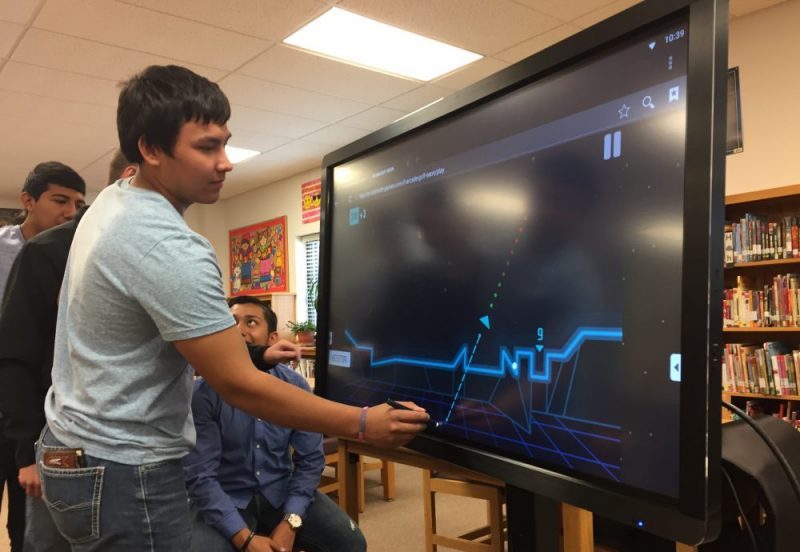Interactivity is essential for flat panels used in education
Interactive flat panels were made for education, as they encourage students to learn in ways that promote retention and engagement. Educators already know the power of collaboration in the classroom, which is why group projects are still a reliable teaching method. According to a student survey published in EdTech Magazine, collaboration in the classroom resulted in students being 13 percent more likely to feel confident speaking during class discussions, while the survey also found significant boots in social-emotional and communication development. Interactive flat panels spark collaboration like no other educational tool. They are perfect for getting students more involved in the lesson and giving them some ownership over their education. The result is better engagement and more enthusiasm for learning.Is interactivity really that important?
A standard, non-interactive display is still an upgrade over blackboards and overhead projectors. Digital displays can produce vivid imagery and be used as a lesson delivery method when paired with another device. Just because a digital display lacks interactivity doesn’t mean it’s static, either. A display can draw attention with video or animation in a way that older lesson delivery methods can’t. According to a survey published by Kaltura, 93 percent of students believe video improves lesson delivery. Digital displays, even if not interactive, can provide that. Interactive flat panels, though, give educators a new set of tools in creating and delivering lessons. Further, the most reputable interactive flat panel manufacturers, such as Promethean and Clevertouch, have robust ecosystems in place to help teachers. Educational resources, applications, templates and lesson ideas are part of these ecosystems, so interactive flat panels never stagnate and become irrelevant. Interactivity is important if educators place top priority on engaging students and subject mastery.Interactive flat panels and active learning
Interactive flat panels add another dimension to the learning experience, with an unmatched ability to seize a student’s attention and hold it. Engagement is something educators are always looking to improve, and it predicts classroom performance extremely well. It’s critical, then, that teachers have tools on hand that will ensure engagement happens. It’s for this reason that educators are turning to active learning methods. Active learning is designed to get students involved in their learning, whether it’s a discussion, an experiment, a game or something else. There’s a lot of research favorable toward active learning, including a study published in Biochemistry and Molecular Biology Education that showed students improved their critical thinking, problem solving and content knowledge with active learning methods. Other studies have found that active learning improves communication, interpersonal skills, creative abilities and enthusiasm for school. Active learning is what educators are using to get better performance and participation from their students. Interactive flat panels encourage participation in several ways, including:1. They drive communication between students – Students are better engaged when they are required to solve problems with each other. Interactive flat panels provide many opportunities to work together on problems and tackle them as a group. As interactive flat panels are designed for 10 or more simultaneous touch points, several students can work together to complete a quiz, play a game or organize a brainstorming session to solve a problem.
As interactive flat panels are fun for students to use, communication between users tends to be more cooperative. It’s tough to be uncooperative when using a novel technology like interactive flat panels.
2. They give students the freedom of choice – A study published by Ben Gurion University in Israel demonstrated the power of giving students meaningful choices. That study found that if students were allowed to choose from a set of lessons, and given clear instructions on how to do so, they were far more engaged in their work. It was important that these choices were meaningful to the student, and that they aligned with the lesson’s goals.
Students are capable of effectively directing some aspects of their education, and interactive flat panels provide the optimal environment for doing so. With a comprehensive bank of educational resources to draw from, teachers can put together a handful of quick lessons on a single topic, and allow students to pick from them. This simple approach is enough to get the student committed to their learning.
3. They engage students in a novel, yet familiar way – Active learning takes off when students want to engage in the activity. That’s why games are such powerful learning tools. Interactive flat panels also provide the fun factor that gets students’ attention, and they do so in a way that students won’t be confused.
The Clevertouch and ActivPanel are built on familiar Android interfaces that pretty much every middle school student, and up, has mastered. An interactive flat panel, then, works like a giant phone, which is always going to be a plus among this naturally teach-savvy generation of students. Interactive flat panels, though, ramp up the novelty with their size, their role in the classroom and their focus on collaboration. It makes for a memorable experience, even if children don’t realize they’re learning something at the same time.
Interactive flat panels have a massive role in education, as learning tools, engagement tools, collaboration tools and for the occasional bit of fun. They’re never rendered obsolete or irrelevant, either, because the ecosystems that back interactive flat panels ensure there is always a new lesson ready to be made.


